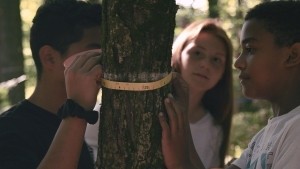Pam Ames has been an educator for more than 30 years, the last 13 of them at Killingly Intermediate School in northeastern Connecticut, where she teaches seventh grade science. She brings to her work a keen interest in connecting her students with local nature. There’s a small forest adjacent to the school, where Ames and her colleague Michael Morrill guide some 170 seventh graders each year through scientific data collection – including identifying and recording plant species, measuring tree diameter and growth, and observing human activity in the forest. Their work contributes to Harvard Forest’s Long Term Ecological Research (LTER) program.
I grew up in Meriden, Connecticut during the 1970s. Some of my favorite memories from childhood are of time in the woods around my neighborhood, where I spent many hours exploring with my siblings and friends. I’m from a large family – I have two older sisters and two older brothers and a little brother. Any time we could be outside, we were outside. We’d meet up in the woods. We made forts out of sticks and ferns. Sometimes we’d try to figure out where the big kids’ fort was. We played hide-and-seek and went ice skating in winter. My mom would ring the bell when it was time to come home for dinner.
My husband is also a teacher, and he had an opportunity to teach at The Rectory School, a private school in Pomfret, near Killingly. We live on campus, and there are trails through the woods. When our boys – now 16 and 13 – were little, I would take them out for walks. As they got older and more inquisitive, we would go along the trails and into the woods. There was a place they could catch frogs, and they’d catch as many as they could, then let them go.
The forest study program fits really nicely with our unit on ecosystems, and our students get to be real, live scientists. We have our forest plots, and we are working alongside all these other schools in trying to collect this data for Harvard. We’re talking about invasive species. We look at how the growth of the trees changed from last year to this year. And we’re looking at news on climate change and trying to connect these weather patterns to what we’re seeing in our own backyard – how these events affect the overall health of our trees, plants, or even the animals that live in our school forest.
We have a lot of kids who camp and hike with their folks or love animals and they love going outside. And we have others who spend very little time outside with their families and at first don’t like to go into the forest. Some of them don’t like bugs or don’t want to get dirty. Overall, I think they feel it’s a privilege to be able to go outside during school. It’s kind of like recess, and we’re exploring. The data collecting we do in our forest is being used by Harvard scientists who have been trying to figure out how the forests of the Northeast are changing over time. The students really understand the importance of how our data is being tracked along with other schools in our area. Being outside of the classroom, being in touch with nature, helps keep their stress levels down. It’s a nice change from sitting at a desk.
Working outdoors several times a year with my students keeps me relaxed and focused. Teaching has changed a lot over thirty years, and you can get pretty burned out. A couple of years ago, during a particularly stressful time, I really questioned whether or not I wanted to stay in the profession. I don’t know if it’s the type of students I have now or that we’re going outside, but it’s just been a nice change of pace to be outside. I smell the forest. I’m smelling the trees. I can smell the leaves. It brings back memories. We’re trying to get that excitement instilled in the kids as well. It really is magical when you go out there – and when you see it in someone else’s eyes.
I would hope that I could instill in students the importance of preserving what we have. Climate change is a big part of our curriculum, and we keep circling back to that. This has a lot to do with their future. We hope our students get a better appreciation of the outdoors so that they can help educate their family and friends about climate change and speak up about what we can do to help.


